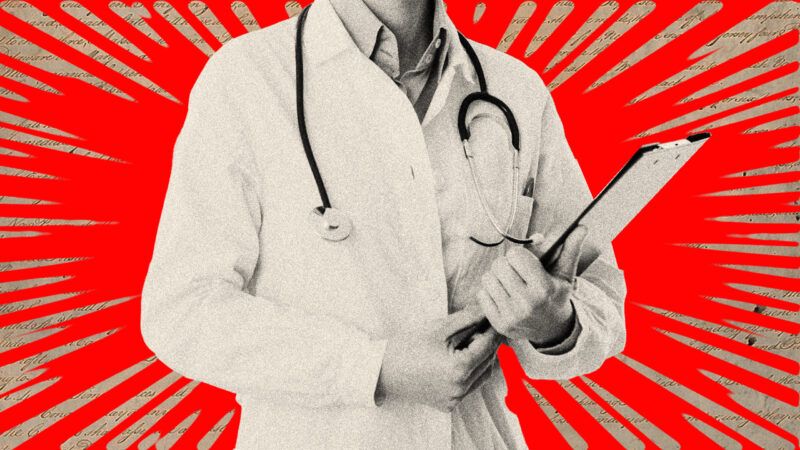Dobbs Opened Up an Attack on Doctors
The Supreme Court decision overturning Roe has made bad law and bad medicine

Americans are rightly shocked by the news of a 10-year-old rape victim who had to cross state lines to lawfully terminate her pregnancy. The girl's home state of Ohio outlawed abortion in the wake of Dobbs v. Jackson Women's Health Organization, the recent Supreme Court decision overturning Roe v. Wade. So the girl's doctors referred her out of state for the medical procedure that saved her from grievous physical injury and possible death. Making matters worse, the law-abiding Indiana doctor who performed the abortion had her judgment questioned by her state's grandstanding attorney general, who raised the specter of legal action against the doctor.
The whole sorry affair should remind us of one key reason why Roe was decided in the first place: to protect doctors.
It is a sad fact that some doctors will avoid providing essential medical care if the treatment in question is politically controversial. These doctors understandably fear that an overzealous prosecutor might use a vague law against them, just as Indiana's attorney general threatened to do here.
Doctors who deal in certain types of pharmaceuticals run the same risks. In fact, just three days after Dobbs, the Supreme Court actually enhanced the legal protections for doctors who prescribe opioids. In an ironic twist, the Court did so while effectively reviving a pre-Roe case that protected the medical privacy rights of abortion providers.
The opioid case is Ruan v. United States. Xiulu Ruan is a licensed practitioner authorized to prescribe opioid painkillers. Like many other doctors, he faced a cruel dilemma: Write too many prescriptions, and prosecutors might come knocking. To avoid unwelcome prosecutorial attention, doctors often ignore their own best medical judgment and leave suffering patients untreated. But Ruan wrote the prescriptions.
The Supreme Court ruled 9–0 in his favor but was split on the rationale. Writing for six members of the Court, Justice Stephen Breyer set up a framework for doctors and prosecutors to follow in these sorts of cases. First, doctors must show they are qualified to prescribe the drugs in question. Once they do that, the federal courts must presume that the doctors acted lawfully and responsibly. It is then the government's sole burden to prove otherwise.
Writing in concurrence, Justice Samuel Alito argued that the burden should have been placed on doctors to prove that their conduct was lawful and responsible, even if that requirement chilled legal medical care. Alito also denounced Breyer's sensible approach as a "radical new course." But Breyer's holding was neither radical nor new. The Supreme Court first adopted such a rule in the 1971 case of United States v. Vuitch.
Vuitch is an oft-forgotten precursor to Roe. At issue was whether the "life and health" exceptions to a D.C. abortion ban were unconstitutionally vague. The Court resolved the matter by adopting a doctor-friendly standard. First, doctors had to show that they were licensed medical professionals. Second, the "life and health" exception was interpreted to include the mental and physical health of the patient. Third, the government was forced to shoulder the burden of proof, demonstrating that the doctors had failed to act in good faith or in accordance with medical standards. The government also had to prove that the abortion in question was not necessary to protect the life or health of the woman.
As you may have noticed, this is essentially the same standard that Alito dismissed as a "radical new course" in Ruan.
There is something else notable about Vuitch. Writing in dissent, Justice William O. Douglas observed that whether medical treatment was for "life" or "health" was in the relevant doctor's best judgment, meaning that skeptical juries, swayed by an impassioned prosecutor, might still vote their morals rather than trust a doctor's good faith. That risk, coupled with the inherent vagueness of medical liability standards in general, could still chill lawful medical conduct. Douglas also pointed out that abortion bans with exceptions for the life of the woman, but not for her health, were facing legal challenges in Texas and other places. The Supreme Court would still have to deal with those types of laws.
Which it did. The day after Vuitch was decided, the Court agreed to review the Texas case, which became Roe v. Wade. Although this is sometimes forgotten today, Roe was a medical privacy case at heart. It was all about balancing the rights of doctors and patients with the social goal of reducing or eliminating abortions. Roe protected the private communications and decisions made between doctors and patients seeking a medical procedure.
The Dobbs decision obliterated those medical privacy protections by a narrow 5–4 vote. Yet by a 6–3 vote just three days later, the Supreme Court embraced the logic of Roe's most important predecessor (Vuitch) when it strengthened the medical privacy rights of doctors who prescribe opioids (Ruan).
This contradictory and confusing state of affairs is bad both for medicine and for the law, and it ought to be fixed as soon as possible. Whenever a poorly drafted statute is open to abuse by an overreaching prosecutor, the Supreme Court has the option of using the void-for-vagueness doctrine to strike down the offending law. The Court could also require that all abortion regulations conform to the doctor-friendly rules spelled out in Ruan and Vuitch. Particularly egregious laws, meanwhile, can be invalided by the courts for lacking a rational basis.
The Constitution provides firm procedural safeguards whenever the government interferes with life, liberty, property, or privacy. The Supreme Court needs to ensure that doctors still enjoy those safeguards' benefits.
